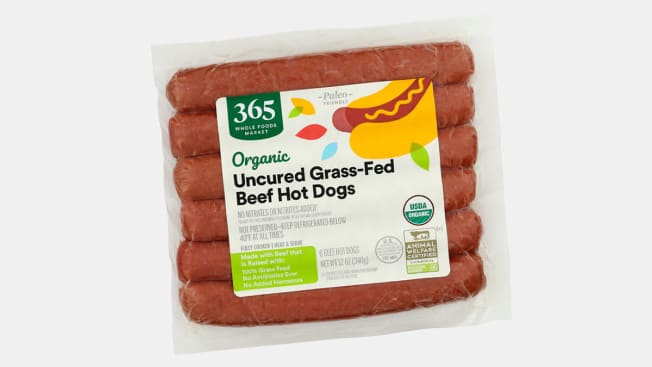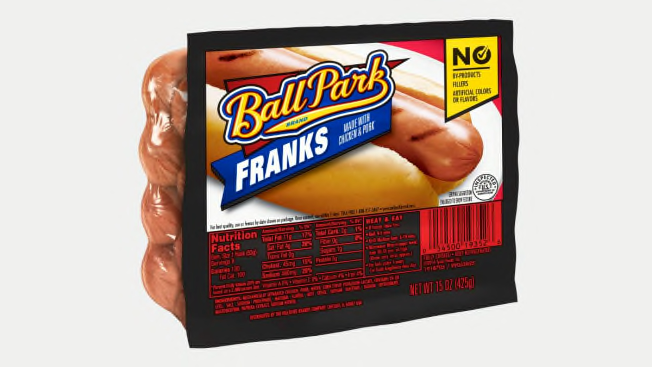Best Hot Dogs
There are no bad dogs—but some dogs are better than others
When you shop through retailer links on our site, we may earn affiliate commissions. 100% of the fees we collect are used to support our nonprofit mission. Learn more.

A hot dog day is a special day. It’s an icon of summer, a hallmark of long, lazy weekends, a souvenir of childhood. Every time I eat a hot dog, I’m thrown back to warm memories: my parents grilling in our shaded backyard, the fragrance of the meat and vegetable kabobs on the grill mingling with citronella candles in the dry California heat, while friends and neighbors kick back with sweating beers and sodas poured into cups heaped with ice. Marcel Proust had his madeleines; I have hot dogs.
Are there bad hot dogs? We set out to discover the answer to this question and are pleased to report the answer is: not really. Most of the hot dogs you find at the grocery store will taste perfectly acceptable on a good potato bun, especially if it’s heaped with relish, mustard, chili cheese, or whatever it is your hot dog-loving heart desires. But some truly are better than others, and while you can’t really go wrong, there are ways to go really right.
Editor's Choice: Nathan’s Famous Skinless Beef Franks

Photo: Nathan's Famous Photo: Nathan's Famous
Price: $6.49 for 8
Where to buy: FreshDirect
The original. The best. The pinnacle of a hot dog. This one comes from one of the oldest hot dog companies in America. Its founder, Nathan Handwerker, was a Polish immigrant who worked at a Coney Island hot dog stand until he was able to scrounge up enough money to open his own business in 1916. That full century of expertise is evident in this hot dog. Paul Hope, my fellow evaluator, who writes about grills and cooktops at Consumer Reports, called it “the Goldilocks of hot dogs: crisp skin, subtle spice, uniform texture, and juicy.” I agree on all counts.
Unlike Nathan’s dogs at the boardwalk, the ones we tried were skinless, though they still produced a subtle, satisfying snap after roasting. I particularly appreciated that their rich, full flavor stood up to toppings of all types—mustard and sauerkraut, hot sauce and mayo, finely chopped kimchi. That said, it’s supremely delicious served plain, which also makes this hot dog an exceptional option for picky, condiment-avoidant children or for hungry adults in a hurry. Its one flaw—that it split in a thin, even line after it was cooked—didn’t affect its juicy texture, so we’ll let it go.
The Umami Dog: Hebrew National Beef Franks

Photo: Hebrew National Photo: Hebrew National
Price: From $5.99 for 6
Where to buy: FreshDirect, Wegmans
This hot dog is so good that it’s almost unfair to classify it as second best. It is, in many ways, as good as a Nathan’s hot dog. This beef frank is longer and thinner than Nathan’s, and as a result is somewhat drier, but not enough to make too much of a difference in how much we enjoyed it. It has a fatty, umami-rich flavor that tastes a little saltier than the Nathan’s (though it actually has less sodium), and has a smoky, well-spiced complexity that makes it appropriate for more adventurous condiments, should that be the direction you want to go in. (I’m particularly interested in trying my next hot dog with peanut satay sauce, pickled carrots, crushed peanuts, and Sriracha, a concoction inspired by a Claire Saffitz recommendation in Bon Appétit.) The Hebrew National is not adults-only. “It reminds me of childhood,” says Paul, whose parents kept them in the house when he was growing up.
The Over-the-Top Flavor Dog: Oscar Mayer Uncured Original Wieners

Photo: Oscar Mayer Photo: Oscar Mayer
Price: $5.79 for 10
Where to buy: Amazon
This is a kid-friendly hot dog that nevertheless doesn’t skimp on flavor, with a slightly smoky taste, an even, delightfully bouncy texture, and a rich, fatty flavor that’s simple and straightforward enough to appeal to young, less sophisticated palates. It also has almost no snap, which we found disappointing, but which children who require perfectly uniform food (I was like that as a kid) may appreciate.
What it lacks in snap and complexity, though, it makes up for in intensity. In my evaluation, I called this “the most hot dog hot dog.” It has what can only be described as a distinct hot dog essence. Like a scientist was put in a lab to create the hot dog that would go into a museum or time capsule, the representative hot dog. Not the best, but the most. Paul called it “very juicy” but “limp” and “uninspired,” adding that he’d want to “dress it up quite a bit with toppings.” Or perhaps, because of its supreme hot dog-ness, you might want to throw it into a hot dog salad?
The Snappiest Dog: 365 Everyday Value Organic Uncured Grass-Fed Beef Hot Dog

Photo: Whole Foods Photo: Whole Foods
Price: $7.49 for 6
Where to buy: Amazon
If you need your hot dog to be organic, get this one. But it’s not going to blow you away. This was the only one that disappointed me. It’s dry, blander even than the Ball Park below, and requires a boatload of toppings to be truly delicious. It does, however, have a redeeming quality: It has the snappiest exterior of any of the hot dogs we tasted, making it a true delight to bite into. Though it’s at the bottom of the list, I’d eat it again. I’d just make sure to really load it up with, say, my new favorite sambal. And maybe some thinly sliced peppers for crunch.
The Hot Dog We’d Skip: Ball Park Classic Franks

Photo: Ball Park Photo: Ball Park
Price: $2.97 for 8
Where to buy: Walmart
This hot dog is the epitome of “sure, why not?” It’s the kind you’d be into when you’re so drunk you’d eat a shoe if it had ketchup and mustard on it. But if you’re going to the grocery store to pick out a hot dog for a barbecue, do right by your guests: Buy something else if there’s another brand available.
It’s juicy, we’ll give it that. And it’s not disgusting. It’s just disappointing. The Ball Park dog is rather bland—underspiced, without enough of that crucial smoky, garlicky flavor that makes hot dogs so spectacular and special. And it was messy to cook. Paul called it “fickle,” saying that it burst while cooking and that its skin separated from the inner meat. Mine didn’t burst, but it did bubble and blacken in spots, though we cooked it the exact same way as the others. It’s likely that this hot dog requires a lower temperature and more careful cooking than the others, which kind of defeats the point. Hot dogs should be easy. They should not require much thought, in either their preparation or their consumption. (Though elective, in-depth consideration of the preparation and consumption of hot dogs can be a blast, obviously.) While the Ball Park is really only good enough for late-night snacks, with so many better options you’re better off choosing something else.
@consumerreports @consumerreports Part 2! We taste-tested a selection of hot dogs, including meat-free options, to help you make the best decision this summer. #foodie #foodtok #foodtiktok #hotdog ♬ original sound - Consumer Reports
How We Evaluated the Hot Dogs
First, we took a bite of each hot dog totally plain: no ketchup, no bun, nothing. Then we tried the hot dogs with our favorite assorted toppings. We assessed these hot dogs according to a few criteria.
How snappy is it? The best should bite back. Just kidding! If this happens, get medical help. But seriously, a good hot dog should have a snappy skin over a bouncy, even internal texture.
How juicy is it? Moisture is an integral feature of a good hot dog. In my opinion, it’s the most critical feature of a hot dog, because you can add flavor but you can’t add juice.
How flavorful is it? Hot dogs should be rich and fatty, with a smoky, garlicky undertone. It should be salty, but it shouldn’t make your mouth pucker.
How smooth is it? Hot dogs should have a perfectly even texture once you get past the snappy skin. Though chunky hot dogs used to be more common than they are today, you can still find some that are gritty or overly firm. No thanks.
@consumerreports Ketchup vs. mustard: Which condiment do you prefer on a hot dog? 🌭 #foodtiktok #hotdog #foodtok ♬ original sound - Consumer Reports
How We Cooked the Hot Dogs
Hot dogs can be cooked any number of ways—grilled (iconic, celebratory), boiled (quick and easy), steamed, microwaved, or roasted. At the advice of Brent Young, a butcher and owner of The Meat Hook meat shop in Brooklyn, N.Y., we roasted our dogs in a 400° F oven because I don’t have a grill, cooking them for 10 minutes. Though hot dogs are fully cooked straight out of the package, which decreases the likelihood of food poisoning, bacteria can still be introduced during packing. For that reason, Consumer Reports food safety experts agree with Department of Agriculture recommendations that home cooks, especially those prone to foodborne illness, cook a hot dog until “steaming hot.”
Hot Dogs: An American Classic
According to the National Hot Dog & Sausage Council, a trade association founded by the larger American Meat Institute, hot dogs—interchangeable with the terms “frankfurters” and “wieners”—are usually made with either all beef or a combination of beef and pork. Ice is sometimes added to encourage emulsification or to help break down curing ingredients, like nitrites or nitrates.
Hot dogs made with byproducts or “variety meats” such as heart and liver are less common now than in the past, and those that contain 15 percent or more of these animal parts must have them listed under the ingredients.
These trusty little wieners originally appeared in the U.S. courtesy of German immigrants in the 1850s and 1860s, who called them frankfurters, wieners, or red hots. They became popular on college campuses such as Yale, which had a lunch cart called the Kennel Club that students called the “dog wagon.” The earliest known reference to the term “hot dog” is from an 1892 issue of the New Jersey newspaper The Paterson Daily Press, which, according to Yale Law librarian Fred Shapiro, referenced a child ordering a frankfurter by demanding a “hot dog, quick.”
The highly processed sausages have been an American staple since the 1920s, when hot dog carts patrolled the mean streets of New York and New Jersey hawking their smoky-smelling wares. One 1925 publication claimed, “it is the chunk of meat and the loaf of bread for a dime that makes the Hot Dog a favorite with American pocketbooks . . . the Hot Dog satisfies the appetite of millions who must have a bite between meals.”
Early hot dog purveyors and assemblers were primarily immigrants, such as Oscar F. Mayer (German), Nathan Handwerker (Polish), and a Black man from the Caribbean named Thomas Francis Xavier Morris. In large part because of negative sentiment about immigrants, many Americans were suspicious of hot dogs and other sausages, though quality at the time varied considerably more than it does now. But in the following decades, new technology allowed for greater consistency in hot dog processing. Now, one of the most crucial features is its smooth, fully emulsified interior, which differentiates it from similar sausages like the bratwurst, which has a more traditional, chunky sausage grind.
This new technology is critical to producing a high-quality hot dog. “I think people turn up their noses at the idea of a supermarket hot dog. But the thing that actually gives a regular hot dog its consistency is the process of emulsification,” Young says. Hot dogs have to be processed through what he describes as “basically a Cuisinart food processor—only like the size of a room. That heavy-duty machinery is what actually creates the bind of ground meat and ice together so that it can get the consistency of its snappiness.” You can’t really make hot dogs at home with a personal KitchenAid, he says, because the motor won’t be strong enough to fully emulsify the meat.




















